2018 Honda Accord 1.5T Touring
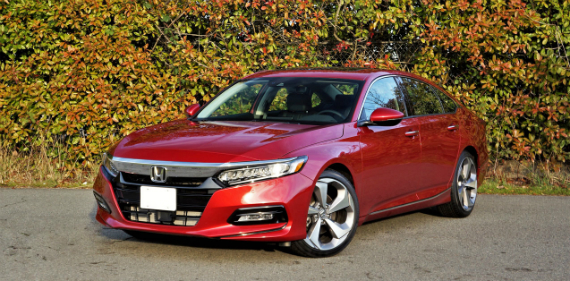
Honda's new design language has fully taken shape in the latest Accord, this popular midsize model fully redesigned from the ground up for 2018. It’s the longest, leanest, sportiest Accord yet, and follows many of the current Civic four-door’s coupe-like styling cues, but to my eyes it’s much more pleasingly orchestrated.
This near top-tier version of the Accord’s ritziest Touring trim line has a bit more chrome than all lower grades, excepting the EX and EX-L, which not only brightens the leading edge of the grille and hood before striking through the swept-back wrap-around headlights as done with all models, not to mention the upper portion of the side window surrounds and the slightly angular albeit mostly ovoid tailpipes in back, but also garnishes the otherwise body-color door handles as well as the extended rocker moldings below the doors, the latter metal brightwork sweeping upward to each corner of the rear bumper.
The headlights dazzle as well. Their trademark jewel-like vertical pattern signifies standard LEDs, albeit just for low beam use in all trims but Touring that gets full low and high beam LED clusters. Their outer edges are surrounded in LED signature driving lights, with all but base models visually supported by a narrow set of LED fog lamps integrated within the lower fascia below. Additionally, wafer thin LED turn signals get fitted to the side mirror housings of all trims above the same base LX. The LED taillights are standard, plus their dramatic yet elegant C-like shape is completely unique in an industry that oftentimes isn’t too creative. The lower portions aren’t just reflectors either, but join the upper sections by lighting up with LEDs to provide a stylish nighttime statement.
Honda has taken the Accord’s new-edge design inside as well, toning the drama down slightly albeit still delivering a stylish, high-tech experience. For instance, the standard primary gauge package includes a partially configurable 7.0-inch color TFT display in place of the usual mechanical tachometer, and it’s so realistic I actually thought the entire cluster was analog when first sliding behind the wheel. In fact, about 60 percent of the left-side cluster is a high-resolution multi-information display that defaults to a tachometer, but otherwise can be used for myriad functions. The right-side speedometer spins via conventional means, while the temperature and fuel indicators to each side are separate backlit gauges.
Looking back, the outgoing Accord included twin digital displays to each side of an analog speedometer, with a small multi-info display at center, and while this was bright and colorful, especially in the Accord Hybrid Touring model last tested, this new design provides a larger more useful digital display.
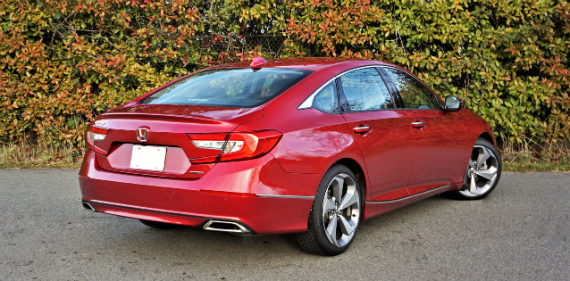
Likewise, Honda has simplified its main center stack-mounted infotainment system too, with its previous two-screen approach now reduced to one single 8.0-inch touch capacitive display above base trim, which makes do with a 7.0-inch monitor. This makes sense on so many levels, especially cost, but also from a user experience perspective as the new system is much easier to live with. It starts with a newer more advanced touchscreen featuring most peoples’ preferred tablet-style gloss finish, which improves contrast levels and depth of color, while graphics now mimic Apple’s colorful iPhone/iPad interface, resulting in a simple layout that’s easy on the eyes.
On that note the larger display incorporates Apple CarPlay and Android Auto smartphone connectivity, Siri Eyes Free compatibility, plus you can modulate many of the system’s applications via smartphone/tablet-style tap, pinch and/or swipe gesture controls.
Smartphones in mind, I think most will agree that CarPlay works better than Android Auto, but Android fans with the latest gear can feel good about the availability of NFC (Near Field Communication), which comes standard with Touring trim (look for the stylized “N” on the dash trim ahead of the front passenger), making connectivity easier than ever. The rest of us will need to make do with standard HandsFreeLink, which gave me and my cheap but serviceable Honor (Huawei) GR5 no issue.
The standard parking monitor was clear and bright, plus offered multiple angles to choose from, while dynamic guidelines made slotting into a parking spot easier. Interestingly, Honda doesn’t include an overhead parking monitor as part of its top-line offering, but instead provides a digital version that lights up colored warnings when getting too close to an object, this working in conjunction with audible beeps from my Touring trimmed model’s front and rear parking sensors.
Touring trim also adds satellite-linked navigation with detailed mapping, a system that’s worked brilliantly in previous Honda models and still does in the new infotainment system, while Honda’s voice recognition is more capable of understanding my miscellaneous utterings than average.
Touring models also include a wireless charging pad within a lidded bin at the base of the center stack, this also filled with a 2.5-amp USB charging port and a 12-volt plug, while there’s a second USB charging port in the storage bin under the center armrest, plus in EX trims and above you’ll get two more USB ports on the backside of the front console for rear passengers.

Now that we’re talking Touring features, a shortlist of exclusive items not yet mentioned include ambient door handle lighting, rain-sensing wipers, a head-up display that projects key info onto the windshield ahead of the driver, ventilated front seats, mobile hotspot capability, HondaLink Subscription Services (such as Enhanced Roadside Assistance, Auto Collision Notification, Emergency Call, a Personal Data Wipe, Remote Start, Security Alarm Alert, Stolen Vehicle Locator Service, Find My Car, Remote Lock and Unlock, Geofence Alert, Speed Alert, Destination by Voice, Personal Concierge, etc), plus more.
In addition, unique features the Touring model shares with the Accord Sport include 19-inch alloy wheels on 235/40 all-seasons (base Accords get 17-inch rims and rubber), and steering wheel-mounted paddle shifters.
Additional items pulled up to the Touring from lesser trims include an electromechanical parking brake, remote engine start, an Eco Assist system, an acoustic windshield, Active Noise Control (ANC), a leather-wrapped multi-function steering wheel, a leather shift knob, an auto-dimming rearview mirror, an overhead sunglasses holder, a HomeLink garage door opener, a powered moonroof, heated front and rear outboard seats, a driver attention monitor, a 12-way powered driver’s seat with memory, a four-way powered front passenger’s seat, perforated leather upholstery, 450-watt AM/FM/MP3/WMA/satellite audio with 10 speakers including a subwoofer, HD radio, Bluetooth streaming audio, SMS text message and email reading capability, Wi-Fi tethering, blindspot monitoring with rear cross-traffic assist, tire pressure monitoring, hill start assist, all the usual active and passive safety features including front knee airbags, convenient capless refueling, and the list goes on.
I purposely left a number of items from the last list of features because I wanted to highlight some of the most impressive kit pulled up from the base model, particularly proximity access with pushbutton ignition, filtered dual-zone automatic climate control, and a Sport mode, items not normally seen so low in the trim level hierarchy.
Even better, the Accord’s standard Honda Sensing suite of advanced driver assistance systems includes Forward Collision Warning (FCW), Collision Mitigation Braking System (CMBS), Lane Departure Warning (LDW), Road Departure Mitigation (RDM), auto high beams, traffic sign recognition, and Adaptive Cruise Control.
This is an impressive safety-first attitude from Honda, and is no doubt partially responsible for its IIHS Top Safety Pick status (when upgrading to those full LED headlamps mentioned earlier) and best-possible five-star NHTSA rating, but it’s probably also why the base Accord’s price has mushroomed by $1,115 from $22,455 to $23,570 plus freight and fees.
The new Accord certainly doesn’t suffer from a quality perspective, with the entire dash top made from high-grade soft-touch synthetic, as are the front door uppers, while rich padded leatherette gets used for the door inserts and armrests, plus premium levels of stitched leatherette padding are added to each side of the lower console, which covers enough area to protect the driver and front passenger’s knees. Additionally, the faux woodgrain and metal inlays are denser and more realistic than in previous Accords, giving the new car higher end appeal.
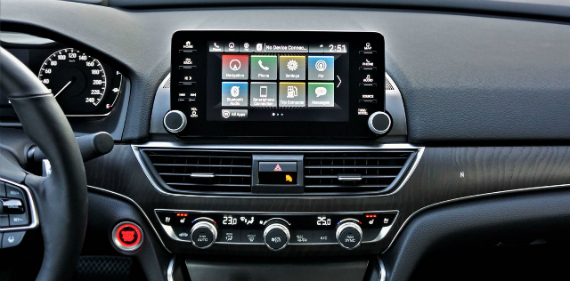
All of the switchgear is superb too, with the door window controls finished in a lovely metallic edging, as is the toggle for the powered mirrors and the surrounds for the memory seats. The same metal can be found throughout the rest of the cabin, whether we’re talking buttons, knobs and rockers like the those found on the auto HVAC interface and electromechanical parking brake lever, or just the trim around the rest of the center stack and lower console, or for that matter the steering wheel which is beautifully shaped and covered in wonderfully soft stitched leather, not to mention backed by a set of satin silver finished paddle shifters. All of the steering wheel switchgear is extremely upscale too, matching many premium sector players.
Most should find the interior design appealing, if not quite as creatively designed as the aforementioned new 2018 Toyota Camry. I certainly found it more comfortable than its archrival, with a driver’s seat you sit within instead of on top of, and as part of that a lower front squab that nicely cups under the hamstrings for better support, plus greater reach from the telescopic steering wheel for improved ergonomics. Still, while the old Accord fit me like a glove, my long-legged, short torso body type forced my arms to reach too far to the steering wheel. It wasn’t as dramatic a stretch as the Camry, but more steering column adjustment would be better.
On the positive, the driver’s seatback provides true four-way powered lumbar support for up and down control instead of just two-way in and out adjustment like the Toyota, not to mention the much pricier Lexus ES that isn’t as comfortable as the Accord for my body type either, while I found the side bolsters did a good job of holding me in place during hard cornering.
While an ideal opportunity to segue into driving dynamics, I can’t forget about those in back that are similarly supported by ideally shaped outboard seats featuring excellent lower back bolstering and well designed cushions under the legs. Legroom is incredibly generous too, with enough space left over to fully stretch out when the front seat was positioned for my five-foot-eight medium-build frame. I had ample side-to-side space too, plus headroom was more than ample for my height and would be for folks that are many inches taller, while a comfortable center armrest and three-way outboard seat warmers added to my Touring model’s luxury. This said the heatable seats took a long time to warm up, both in back and up front.
As you might expect the trunk is nicely carpeted, is large at 16.7 cubic feet, and features the usual 60/40 split for longer cargo, but I still wish Honda would incorporate a more useful 40/20/40 three-way division, or at least a center pass-through for families who ski.
Now that I’m grumbling, I was a bit disappointed there was no panoramic sunroof either, not that they’re normally included in this class, but the Accord just looks so upscale I expected it. Other shortcomings include incandescent reading lights instead of LEDs, and a lack of padded soft-touch door uppers in the rear. Again, not many competitors provide the same level of luxury in back as up front, but it would’ve been a nice nod to near premium buyers who prefer flying under the radar when driving their luxury ride.
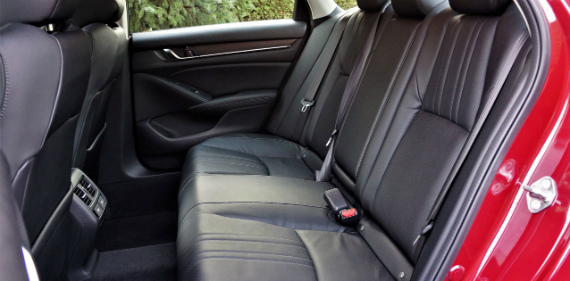
On more of an annoyance note, I’ve become so familiar with touch-sensitive controls from Honda that I kept pressing the “HOME” graphic on the left top portion of the infotainment display instead of the narrow button just below. The same setup is used for all of the other functions, and being that these buttons are not lit up it’s an easier mistake to make at night. I’m not sure why Honda didn’t just go with touch-capacitive switchgear to each side of the screen, being that we’re all so used to it from our smartphones and tablets. As it is, most of us only struggle with touch-sensitive slider-style volume and tuning controls, which Honda has thankfully done away with by adding nice big rotating dials, but I personally would’ve appreciated touch controls for everything else.
Those familiar with Honda’s top-line Odyssey or Pilot and therefore looking for an unorthodox set of gear selector buttons on the lower console will need to move up to top-tier Accord Sport 2.0 or Touring 2.0 trims, which not only feature a state-of-the-art 10-speed automatic transmission connecting to those buttons but also a turbocharged and direct-injected 2.0-liter four-cylinder good for 252 horsepower and 273 lb-ft of torque. Instead, my tester featured a more conventional gear lever actuating a continuously variable transmission (CVT), which in turn found motivation from a 1.5-liter turbo-four with 192 horsepower and 192 lb-ft of torque. A six-speed manual gearbox comes standard with both Sport trims, but I’ve got to imagine the take-rate on this won’t be high.
My CVT-equipped tester also had a Sport mode as noted earlier, and it really helped the smaller engine accelerate quickly. What’s more, despite the transmission being a CVT shifts were quite crisp, while it held its chosen gear between intervals and responded well to DIY paddle-shift actuation. At the same time it’s a wonderfully smooth transmission that’s ideal for this type of large mid-size sedan.
While pleasantly surprised by how well the base engine and CVT performed, the Accord’s agility around corners was expected, as the popular sedan has long been one of the segment’s best handlers. This said I like the way the new model drives on the open highway better than the outgoing car, particularly its seemingly effortless cruising capability once lifting off the throttle, its lack of kinetic drag shocking.
This is especially good for fuel economy, the model I tested having a highly efficient 30 mpg city, 39 highway and 33 combined rating with the ECON button engaged, making it the most miserly 2018 Accord available. Of note, the Sport 1.5 with the six-speed manual is rated at 26 city, 35 highway and 30 combined, the Sport 2.0 with the same transmission is claimed to get 22, 32 and 26, which is identical to the claimed mileage for the Sport and Touring with the 2.0 and 10-speed auto, while the same combination in lesser trims gets a 23, 34 and 27 mpg rating respectively.
So how does it compare to the outgoing Accord? Last year’s naturally aspirated 2.4-liter four, CVT combo was good for 27 mpg city, 36 highway and 30 combined when configured similarly to my 2018 tester, so they’ve made big progress, while the previous manual was only capable of 23, 32 and 26 respectively.
How about that Camry I’ve mentioned a number of times? The Accord’s chief rival gets 29 city, 41 highway and 34 combined mpg in lesser trims and 28, 39 and 32 in upper trims when mated up to its base four-cylinder, eight-speed auto model, which kind of splits the difference between Honda’s manual and CVT model.
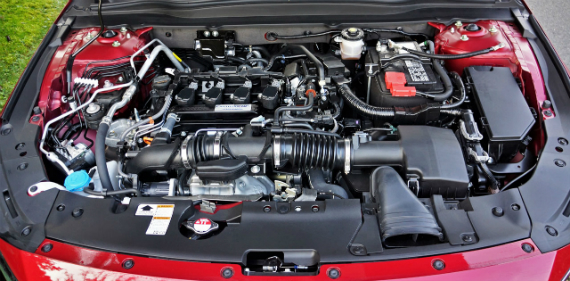
Despite losing market share in recent years (as have all mid-size sedans), it’s been a good year for the new Accord thanks to earning the 2018 North American Car of the Year award in January and many more such prizes since, but unfortunately trophies don’t satisfy shareholders.
To put smiles back on their faces the Accord will need to keep holding its own while the potentially even more profitable Honda Pilot crawls up and out of the mid-size SUV basement where it was outsold by Toyota’s Highlander to the tune of 88,496 units last year. This is now where much of the auto market gains are being made, so Honda may want to rethink its strategy. I’m not going to tell the revered Japanese brand how to run its business, but I’m willing to guess if they were to design a Pilot to look as good as this Accord they’d go a long way toward rectifying the situation.
Yes, the 2018 Honda Accord is one fine looking mid-size sedan that deserves its recent uptick in popularity. If you appreciate the sleeker, sportier styling of a four-door coupe-like sedan and enjoy the more engaging driving dynamics brought about by being closer to the ground, not to mention the benefits of fuel economy this type of lighter weight vehicle allows, I recommend the new Accord over its peers. In my opinion the Accord is the mid-size sedan to own.
*Story credits: Trevor Hofmann, American Auto Press Photo credits: Karen Tuggay, American Auto Press Copyright: American Auto Press *
